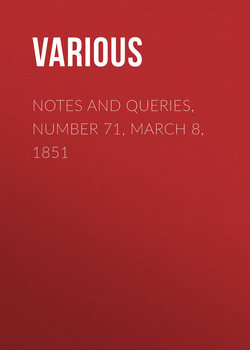Читать книгу Notes and Queries, Number 71, March 8, 1851 - Various - Страница 7
Queries
ОглавлениеBIBLIOGRAPHICAL QUERIES
(Continued from Vol. iii., p. 139.)
(43.) Is there any valid reason for not dating the publication of some of Gerson's treatises at Cologne earlier than the year 1470? and if good cause cannot be shown for withholding from them so high a rank in the scale of typographic being, must we not instantly reject every effort to extenuate Marchand's obtuseness in asserting with reference to Ulric Zell, "On ne voit des éditions de ce Zell qu'en 1494?" (Hist. de l'Imp., p. 56.) Schelhorn's opinion as to the birthright of these tracts is sufficient to awaken an interest concerning them, for he conceived that they should be classed among the earliest works executed with cut moveable characters. (Diat. ad Card. Quirini lib., p. 25. Cf. Seemiller, i. 105.) So far as I can judge, an adequate measure of seniority has not been generally assigned to these Zellian specimens of printing, if it be granted "Coloniam Agrippinam post Moguntinenses primùm recepisse artem." (Meerman, ii. 106.) This writer's representation, in his ninth plate, of the type used in 1467, supplies us with ground for a complete conviction that these undated Gersonian manuals are at least as old as the Augustinus de singularitate clericorum. But why are they not older? Is there any document which has a stronger conjectural claim? Van de Velde's Catalogue, tome i. Gand, 1831, contains notices of some of them; and one volume before me has the first initial letter principally in blue and gold, the rest in red, and all elaborated with a pen. The most unevenly printed, and therefore, I suppose, the primitial gem, is the Tractatus de mendicitate spirituali, in which not only rubiform capitals, but whole words, have been inserted by a chirographer. It is, says Van de Velde, (the former possessor,) on the fly-leaf, "sans chiffres et réclames, en longues lignes de 27 lignes sur les pages entières." The full stop employed is a sort of twofold, recumbent, circumflex or caret; and the most eminent watermark in the paper is a Unicorn, bearing a much more suitable antelopian weapon than is that awkwardly horizontal horn prefixed by Dr. Dibdin to the Oryx in profile which he has depicted in plate vi. appertaining to his life of Caxton: Typographical Antiquities, vol. i.
(44.) Wherein do the ordinary Hymni et Sequentiæ differ from those according to the use of Sarum? Whose is the oldest Expositio commonly attached to both? and respecting it did Badius, in 1502, accomplish much beyond a revision and an amendment of the style? Was not Pynson, in 1497, the printer of the folio edition of the Hymns and Sequences entered in Mr. Dickinson's valuable List of English Service-Books, p. 8.; or is there inaccuracy in the succeeding line? Lastly, was the titular woodcut in Julian Notary's impression, A.D. 1504 (Dibdin, ii. 580.), derived from the decoration of the Hymnarius, and the Textus Sequentiarum cum optimo commento, set forth at Delft by Christian Snellaert, in 1496? From the first page of the latter we receive the following accession to our philological knowledge:
"Diabolus dicitur a dia, quod est duo, et bolos morsus; quasi dupliciter mordens; quia lædit hominem in corpore et anima."
(45.) (1.) In what edition of the Salisbury Missal did the amusing errors in the "Ordo Sponsalium" first occur; and how long were they continued? I allude to the husband's obligation, "to haue and to holde fro thys day wafor beter
